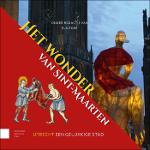Het wonder van Sint-Maarten
Utrecht een gelukkige stad
| dc.contributor.editor | Rose, Els | |
| dc.date.accessioned | 2022-07-11T09:45:30Z | |
| dc.date.available | 2022-07-11T09:45:30Z | |
| dc.date.issued | 2022 | |
| dc.identifier | OCN: 1368421247 | |
| dc.identifier.uri | https://library.oapen.org/handle/20.500.12657/57282 | |
| dc.description.abstract | What makes a happy city? How can a city respond adequately and resiliently to a crisis disrupting civic society? Answers to these timeless questions differ through time. A Miracle of St Martin – Utrecht a Happy City tells the story of Utrecht and St Martin. At the occasion of Utrecht’s 900th anniversary as a free city, the book elucidates how the bond between Utrecht and its patron saint since the early Middle Ages inspired people to contribute to a happy city. The book is designed as a diptych, focusing first on St Martin’s Utrecht patronage around the year 900, when the settlement built within the walls of the former Roman castellum endured difficult times due to political and climatological troubles. Bishop Radbod (899/900-917) calls upon his fellow citizens to cultivate the commemoration of St Martin and to appeal to the saintly figure in times of hardship. The book includes a translation of Radbod’s Miracle Story of St Martin and unravels the secrets of his Gregorian office for the summer feast of St Martin’s Translation on July 4th. The second part of the book focuses on St Martin’s role in the multicultural twenty-first-century city of Utrecht. The popular St Martin’s Parade establishes a new celebration of the saint with music, street art and a parade of lights. Reflecting on this newly (re-)invented tradition we discover St Martin anew as a symbolic figure representing values of the inclusive city in past and present. The book is lavishly illustrated with images of St Martin and his cult in medieval and modern-day Utrecht. | en_US |
| dc.language | Dutch | en_US |
| dc.subject.other | St Martin, medieval Utrecht, urban patronage, medieval music, civic cult of saints | en_US |
| dc.title | Het wonder van Sint-Maarten | en_US |
| dc.title.alternative | Utrecht een gelukkige stad | en_US |
| dc.type | book | |
| oapen.identifier.doi | 10.5117/9789463722766 | en_US |
| oapen.relation.isPublishedBy | dd3d1a33-0ac2-4cfe-a101-355ae1bd857a | en_US |
| oapen.relation.isFundedBy | da087c60-8432-4f58-b2dd-747fc1a60025 | en_US |
| oapen.relation.isbn | 9789463722766 | en_US |
| oapen.collection | Dutch Research Council (NWO) | en_US |
| oapen.pages | 240 | en_US |
| oapen.place.publication | Amsterdam | en_US |
| oapen.remark.public | Funder name: Deze publicatie is tot stand gekomen met steun van: Nederlandse organisatie voor wetenschappelijk onderzoek NWO, Elise Mathilde Fonds, Stichting Hendrik Muller’s Vaderlandsch Fonds, Provinciaal Utrechts Genootschap voor Kunsten en Wetenschappen, Stichting Sormani Fonds, Van Baaren Stichting, K.F. Hein Fonds, Stichting Het Nuyensfonds, Stichting Zonneweelde, Fentener van Vlissingen Fonds, Carel Nengerman Fonds, Stichting Professor van Winter Fonds, Mien van ‘t Sant Fonds, Mr. Paul de Gruyter Fonds, Provincie Utrecht. |

